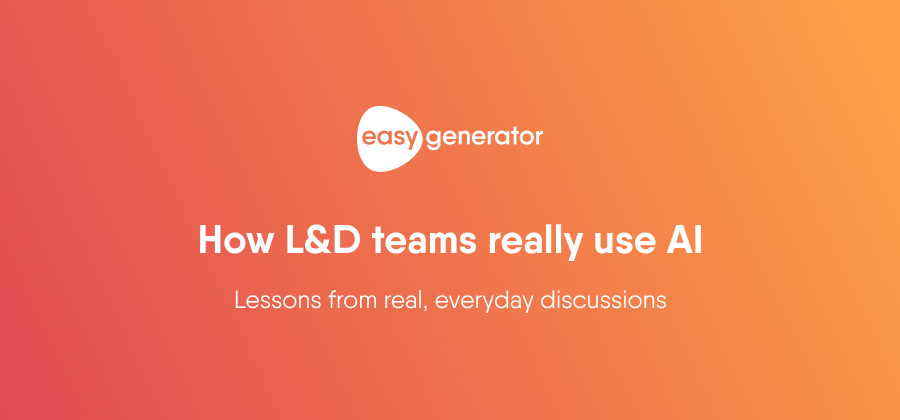What is agile instructional design?
Training shouldn’t feel outdated the moment it’s launched. Agile instructional design helps companies create fast, flexible, and always up-to-date learning.

Many companies use the ADDIE model (Analysis, Design, Development, Implementation, and Evaluation) to create training programs. While this step-by-step method has worked for years, it can be too slow for today’s workplace. When a course is ready, the content might already be outdated.
Agile instructional design offers a better way. Inspired by agile software development, it focuses on flexibility, speed, and ongoing feedback. This means courses are built faster, updated more often, and designed with learners in mind.
This article explains agile instructional design, how it works, and why it helps companies train employees faster and better.
Understanding agile instructional design
Agile instructional design is a flexible way to create training. Instead of following a strict plan, teams build courses in small steps, test them, and improve them as they go.
Key principles of the agile instructional design model include:
- Iterative development: training content is built in small cycles and refined over time.
- Continuous feedback: learners, subject-matter experts (SMEs), and stakeholders provide feedback throughout the process.
- Learner-centric approach: the focus is on engaging and adapting to learners’ needs rather than following a rigid design structure.
ADDIE vs. agile instructional design

Agile learning design follows the same idea as agile software development. Just like tech teams release updates instead of waiting to launch a perfect product, training teams release small lessons and improve them over time.
Read more about why the ADDIE model is outdated for your L&D strategy.
The agile instructional design process
Unlike traditional models that separate content creation from feedback, the agile instructional design process is continuous and dynamic. Here’s how it typically works:
1. Analysis and rapid prototyping
Instead of spending months on planning, designers quickly build a prototype or a minimum viable course (MVC). This could be a small module or an interactive draft shared with learners and stakeholders for early input.
2. Testing and feedback
Learners and SMEs review the prototype and provide real-time feedback. This ensures the course is relevant, engaging, and aligned with business goals. In some cases, adaptive learning design can also be used to personalize training based on learner performance and preferences.
3. Iteration and updates
Based on feedback, the course is refined and improved. This cycle continues until the training meets the desired learning objectives.
4. Implementation and continuous improvement
Once the course is live, it doesn’t mean it’s “finished.” With agile instructional design, content is regularly updated to stay relevant. Training materials evolve as business needs change.
Who is involved?
Agile instructional design brings together a collaborative team, including:
- Instructional designers: facilitate the design process and ensure learning best practices.
- SMEs: provide expertise and help create accurate, up-to-date content.
- Learners: give feedback to shape the learning experience.
- Managers: ensure alignment with business goals.
Benefits of agile instructional design
- Faster course development: training can be launched in weeks instead of months.
- Real-time improvements: courses evolve based on learner needs.
- Better alignment with business needs: training stays relevant and impactful.
Agile instructional design methods and models
One of the most well-known agile instructional design models is the Successive Approximation Model (SAM). SAM follows a rapid prototyping approach, allowing teams to quickly design, test, and refine training materials. Instead of waiting until the end to evaluate a course, designers collect feedback at multiple stages.
How Employee-generated Learning fits in
A key component of agile instructional design is Employee-generated Learning (EGL). Rather than relying solely on instructional designers, EGL allows SMEs to create and update training content. This decentralized approach ensures that knowledge is captured and shared quickly, without bottlenecks.
For example, in a fast-moving tech company, product updates happen frequently. Instead of waiting for L&D teams to develop training, project managers, product managers, and engineers can create microlearning modules to train employees on new features, keeping learning agile and up to date.
The role of rapid e-learning in agile instructional design
Many people assume that rapid e-learning and agile instructional design are the same but serve different purposes. While both focus on speed and adaptability, rapid e-learning is more about using authoring tools to develop content. In contrast, agile instructional design is a broader methodology that emphasizes iteration and continuous improvement quickly.
That said, rapid e-learning is important in supporting agile instructional design. By following an agile management approach, organizations can enable faster course development and real-time updates to keep training materials fresh, relevant, and aligned with business needs. Here’s how they work together:
How rapid e-learning supports agility:
✔ Speed & iteration: uses authoring tools to develop and update courses quickly.
✔ Flexibility: enables fast adjustments to training materials.
✔ SME-driven content: allows experts to contribute knowledge without needing instructional design expertise.
✔ Lower cost & faster implementation: reduces development time and expenses.
However, rapid e-learning alone does not make a course “agile.” Agile instructional design is a methodology, while rapid e-learning is a development approach.
Conclusion
Agile instructional design helps companies build training faster, improve content based on real feedback, and keep learning relevant. Unlike traditional methods, it allows for quick updates and ongoing improvements.
Businesses can create company-tailored training at scale by using agile instructional design methods like SAM, incorporating Employee-generated Learning, and leveraging rapid e-learning.
Organizations must adopt an agile learning culture to stay competitive, where content evolves with business needs, and learners play an active role in shaping their own development.
-
 14 day trial with access to all features. Start with variety of course templates.
14 day trial with access to all features. Start with variety of course templates. -
 Get unlimited design inspirations. Level up your courses.
Get unlimited design inspirations. Level up your courses. -
 Upload your PowerPoint presentations. Get instant courses created.
Upload your PowerPoint presentations. Get instant courses created.




